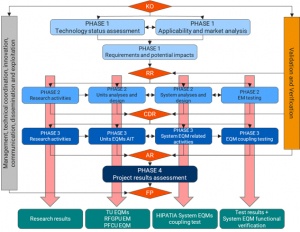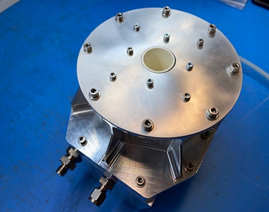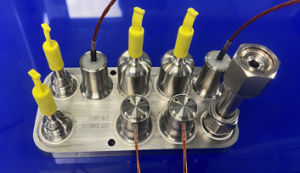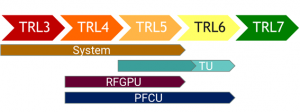About us
HIPATIA (HelIcon PlasmA Thruster for In-Space Applications) was a project funded by the European Commission that aimed to verify the function and the performance of an electromagnetic plasma propulsion system for its application in non-geostationary satellites and other small spacecrafts. The project relied on the Helicon Plasma Thruster (HPT), a technology that can offer a good level of performance while reducing the manufacture costs.
To achieve this goal, the HIPATIA team focused on:
- Developing the HPT technology to fit market needs: this included assessing the performance of the HPT and analysing the impact of the technology in the Space platform.
- Improving the performance of the HPT: the HIPATIA team performed key research and testing activities for this goal.
- Raising the technology readiness level (TRL): HIPATIA aimed to bring the HPT and its associated technologies to TRL6, designing the units and interfaces that support the HPT.
- Planning for higher TRLs and industrialisation: the project assessed the further development needed for full qualification for flight and delivered a business plan.
Workflow
To achieve our goals, we followed these steps:
Impact
The HPT technology aims to revolutionize the space market that is rising nowadays. Its conceptual simplicity and the absence of expensive components bring along several advantages that drastically reduce the manufacture costs of small spacecrafts.
Tackling the challenges of today
In the short term, the HIPATIA innovation could change the paradigm for satellite internet. There is a growing demand for faster broader internet connections that large fleets of small satellites in non-geostationary orbits (LEO) could fulfil. However, this solution would require a large number of satellites. This situation asks for mass manufacturing and cost-capped equipment. The HPT can provide them, thanks to its simple and robust design.
Preparing for the future
In the long term, any spatial mission could benefit from the HIPATIA technology.
- The variety of propellants that the HPT can use could pave the way for applications in VLEO (200-400 km) for orbit observation or scientific missions such as geodesy.
- In-orbit servicing and exploration missions, where high lifetimes and Isp are required. The electrodeless design of the HPT ensures a long operation while still maintain high Isp when compared to chemical propulsion systems.
- Telecommunications geostationary satellites, where orbit raising with EP is interesting as it reduces propellant consumption.
Implemented Methodology
HIPATIA has faced the integration challenges of a complete EP System, constituted by the Thruster Unit, the Radio Frequency Generation and Power Unit that feeds it with power and the Propellant Flow Control Unit that controls the propellant pressure and mass flow. The HIPATIA Project has been organized following three main action lines: Technology design and development, Research activities and, verification and test ; in a time frame of 36 months divided in 4 different phases:
- Thechnology assessment, impact and requirements specification.
- Detailed Design and Analysis.
- Assembly, integration and test.
- Project results assessment.

Work Packages
The HIPATIA Project activities have been distributed in the following 11 different work packages:
- WP1. Management and quality assurance (SENER Aeroespacial).
- WP2. Technical coordination and innovation management (SENER Aeroespacial).
- WP3. Validation and verification (ADS).
- WP4. Technology requirements and potential impacts (ADS).
- WP5. Helicon physics research (UC3M).
- WP6. Thruster unit (SENER Aeroespacial).
- WP7. Propellant flow control unit.
- WP8. Radiofrequency generation power unit (SENER Aeroespacial).
- WP9. HIPATIA system testing (UC3M).
- WP10. Dissemination, communication and exploitation (UC3M).
Technical Achievements and Conclusions
Understanding the complex physics of the Helicon Plasma Thruster is an ongoing effort that requires the combined approach of experimental work, modelling and simulation. Understanding the physics will help to improve the design of future thrusters. The research activities in the HIPATIA project have complemented the activities intended to increase the TRL of the HIPATIA technologies and System:
- Evolution and validation of the 2D hybrid code (axial-radial, PIC/fluid) HYPHEN-HPT. During HIPATIA, the version of HYPHEN specifically suited for HPT has been used. Specific activities were devoted to the improvement of the models implemented in the code, for the validation of the simulation against experiments and for the analysis of the thruster performance with alternative propellants.
- Different HPT design configurations have been analyzed, designed and tested.
- Study of alternative propellants in an helicon reactor and in the HIPATIA TU (argon, xenon, krypton). An iodine feeding system based on a heated tank with a moving piston was designed, built, calibrated and tested with the CNRS Helicon reactor. An iodine RF discharge was ignited and sustained for several hours.
The result of all analyses, design and AIT activities in the project, coordinated by System Engineering, proved the required functionalities during the coupling test campaign. Regarding the resulting System budgets, the HIPATIA system total mass amounts to 10.56kg, the nominal power consumption being between 300W and 450W. Unfortunately, the TU performs at low efficiency 3.7 %, and 8.5 mN of thrust (400 W, 2 mg/s Xe).
HIPATIA SYSTEM units

Thruster Unit

PFCU

RFGPU
In HIPATIA the Technology Readiness Levels (TRLs) are evaluated following the indications on TRL assessment indicated in the dedicated Handbook by ESA. At the end of the HIPATIA project the different units have reached the following levels:


